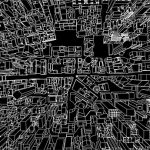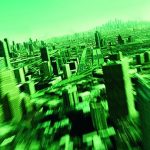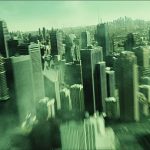An interview with Vlad Bina, arhitect and digital set designer
In 2004, Vlad Bina took part in and won a prize at the Bucharest Architecture Biennial. He had alrready worked on digital set design for famous movies, such as the Matrix sequels/. We interviewed him then, not knowing that it would take another 14 years for a new article, in a very different (also movie) world. Hey, but Matrix may be a classic, but it aged better than movies even 10 years younger. We hope that the next interview will happen sooner than 2032, and for the matter, that we won’t be then in the reality first imagined in 1999. (Z)
Intro & interview: Oana Rotaru
Pictures: Vlad Bînă
I meant to write this article as a classical stylistic analysis, considering the Megacity architecture in terms of a conventional project: its formal coherence within the movie, the way in which the space remains deeply imprinted within the spectator’s visual memory, the delicately balanced mixture of the metropolis’s familiar cliché and the eerie element complementary to any scifi movie. I realized however that using this approach would mean to overlook the specific nature of this project. The project belongs to a new field, digital set design. This implies replacing in part or in full the built sets with digital versions synchronized with the film production space by using a computerized camera rig or through photogrammetric techniques.
Movie set design, especially the digital version, are interesting for architecture for the way they interpret the relationship between the human individual (the spectator) and the built space presented by the film projection. In the case of digital set design, the perceptual viewpoint (represented by the film camera) is moving freely, thus amplifying the sensation of being inside the filmed space. The spectator is thus involved in the story through the visual dynamics and the realism of the digitally created sets, he/she being “brought” in visual situations (points of perception) both within the realm of his/her sensorial experience as well as outside it.
More than a built space, a digital set is a mechanism that unwinds and recomposes the building blocks of visual perception. The resulted space is built around the film camera being based on its interaction with the spectator. From Modernism to the present day, architecture was involved in a continuous search to free the form from a fixed signification. The virtual architecture in feature films reconstructs the equation creatorspace- receptor from classical architecture: once the signification is clearly outlined, the space geometry is carefully designed to “bring” the spectator in the desired point of perception. Present technology allows an advanced synthesis, reproducing reality up to a very a high level of detail. Still, the physical limitations for storing and processing this information demand a visual ierarchy among the computer-generated images, from details to general background images. The image must transmit the minimal amount of information for it to be significant and recognisable.
This involves a selection. The spatial composition is carefully “quantified” based on the statistical speed of gestalt perception. Human perception completes the images familiar to the receptor, the resulted image being whole even if the presented one is incomplete, following the visual “skeleton” of the latter. Thus, the resulted virtual space is a concave one, centred on the “point of view”, intimately linked with the architectural object not in its form but rather in the way the space is appropriated by the spectator/user.
Just as spectacle is a mask that often unveils unknown parts of the real world, set design reveals the essence of architecture – its interaction with the human being. During the last decade this attitude lead to continuous searches for new forms in architecture. The so-called virtual architecture is looking for a way to synthesise the possibilities offered by the digital de-composition – re-composition within a system that would eventually affect the design of real “Megacities”. Is this an evolution or an actual crisis of “real” architecture?
“Unfortunately nobody can be told what the matrix is. You have to see it for yourself.”
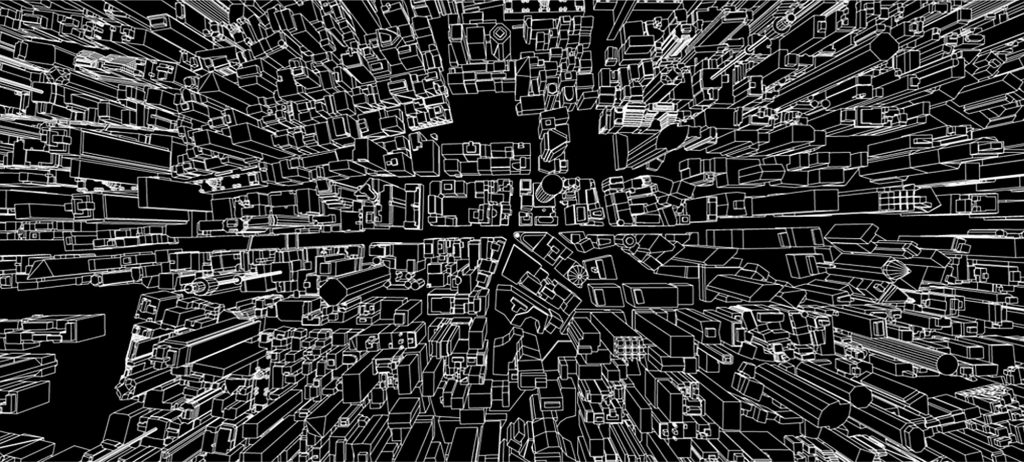
Matrix Revolutions
Warner Bros. 2003, ESC Entertainment.
Activity: digital set-design, modeling and technical direction for the virtual city of the final scene.
Authors: Vlad Bînă
Collaborators: Roger Gibbons, Cristin Pescosolido, (compoziție digitală/digital compositing)
During the 3D modeling we use a wide range of software and technology including 3D laser scanners, photogrametric reconstruction software, photos with a wide exposure as well as classic 3D models and renderings. The possibility to integrate real space with the virtual one made way to unexpected innovations in representation and analysis, thus allowing a complete flexibility of the camera. The final scene of the movie was filmed completely in the studio and the virtual city images were added afterwards.

Vlad Bina explains in the following paragraphs the technicaldata of certain elements of digital architecture from the movies “Matrix Reloaded” and “Matrix Revolutions”. Due to his formation as an architect Vlad has been responsible for the design, construction and integration of urban and architectural elements for 2 sequences lasting 20 minutes for the “Matrix” series, as well as for the design and construction of the digital extension of a real set for the movie “13 Ghosts”. For the last nine years Vlad contributed as a designer to 4 television and video projects and 5 movies for several American studios.
Oana Rotaru: What is a virtual set design project for a film production?
Vlad Bînă: The digital set design production process proceeds as following: one begins with a series of storyboards based on the script. A pre-visualization team (a niche that appeared in the last 10 years) is then assembled to work with the director in a 3D program. They parameterize the space and the camera movement design. Sometimes the pre-visualization is detailed further in the studio by the actual designer responsible for the sequence (as we did for the freeway chase). The result is a visual skeleton of the sequence, a series of QuickTime movies outlining spatial suggestions (simple geometries, planar grids), the camera framing and movement. If the sequence involves a real space, the camera data from the pre-visualization file is transferred digitally to the real camera. In the case of full CG sequence (like the freeway chase fly-over), the camera is transferred directly to the working 3D file.
This process creates a good framework for the shot development. The space design is always created around the film camera. It is useless to work off frame. Due to this fact, strictly geometrically speaking, the space’s footprint sometimes looks strange. For example, in the “Reloaded” freeway chase flythrough sets, the proportions of the background buildings were correct in the camera view, but their footprints were elongated and the distances exaggerated to increase the relative parallax changes. The level of detail for the buildings and spaces is also determined by the camera position.
An interesting observation: the critical mass that made the shot photo real was reached when we added small telephone poles along the industrial areas. They created a dynamic parallax change between the objects and completed the 3D space perception. In the night shots, the rooftop antennae had the same role.
Light and texture have an important role in the process. I worked with a British team that was especially concerned by the initial quality of the photographs used for texturing. They were shooting three different exposures for each image, combining them into an uncompressed image file. This process increased the visual information in both the darkest and the lightest areas of the captured image. This method was used for the aerial sequence in “Matrix Revolutions”.
For the freeway flyover, I collected the necessary textures in a more eclectic way. I remember that some textures originated in a series of black and white industrial pictures. The scene lighting was generated by a system composed of 32 directional digital lights, extracted from the real scenes of the previous sequence. The virtual city geometry for the freeway fly-over was assembled in an ad-hoc way, some built from scratch, some collected from Oakland or San Francisco.
For the aerial sequence, the base building module was a small area from downtown Sydney, amplified then to the size and the structure of a much larger city and textured with aerial pictures. The model was then rendered onto 6 digital hi-res tiles, that were in their turn re-projected on a hemisphere. I worked with a painter (Roger Gibbons) to finish these tiles.
The projection system produced a realistic and flexible approximation for the city geometry. The file for the hemispherical projection was small enough to be used in the pre-vis testing, offering a good framework for adding further detail. There is a full correspondence between the 3D model and the projection, allowing us to generate in Maya the customary rendering passes for compositors: specular, fog, z-depth, y-depth, reflection and normal passes.
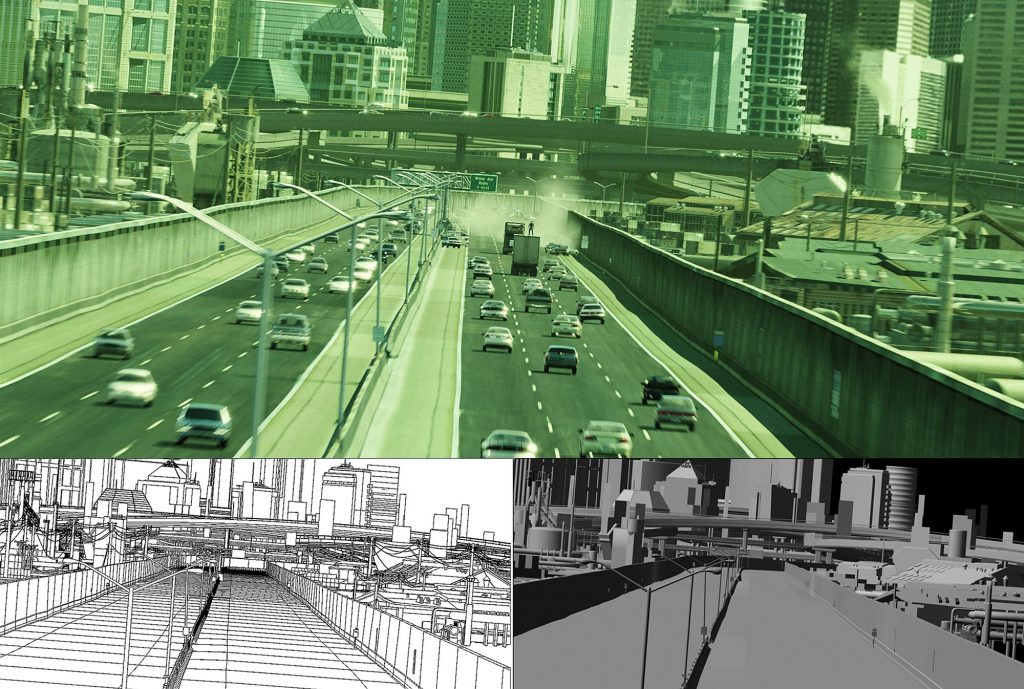
Matrix Reloaded
Warner Bros. 2003, ESC Entertainment:
Activities: digital set-design, design, modeling, colors and lights for the digital part of the highway, the industrial area and the virtual city
Authors:Vlad Bînă
Collaborators: Kody Sabourin, Ben Gunsberger, Adrian de Wet (digital compositing)
Digital set-design is a new area involving the replacement, total or partial, of the built sets with digital equivalents. The 2 versions of the sets are matched either by using a computerized camera rig or through photogrammetric techniques.The images above were created completely on the computer, and are following a hybrid sequence with both digital and real elements filmed in the studio.
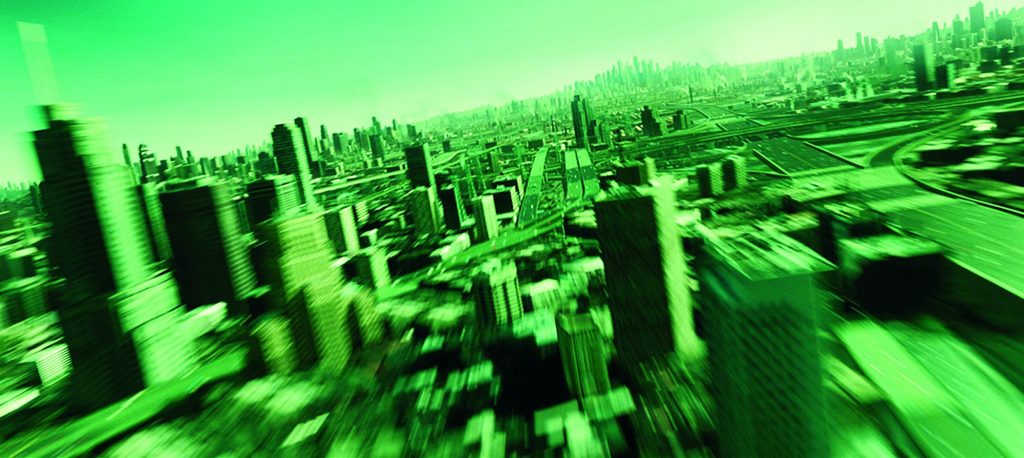
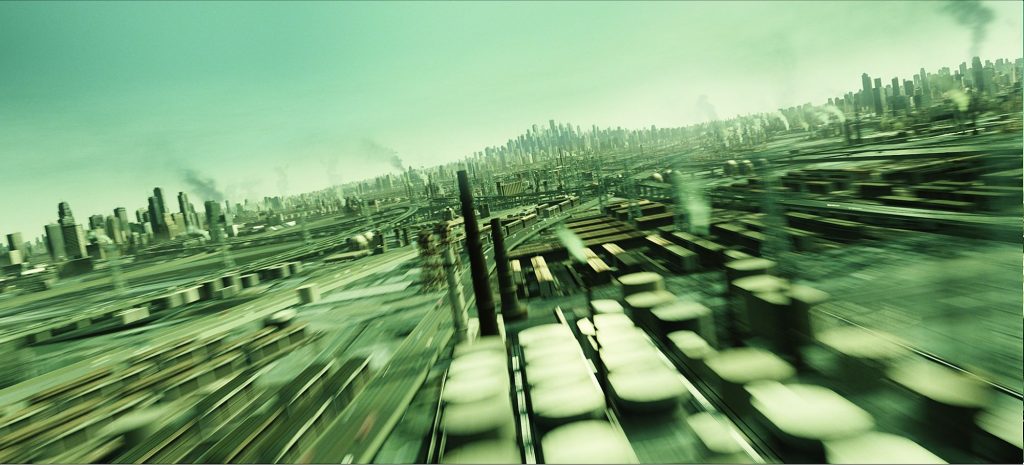
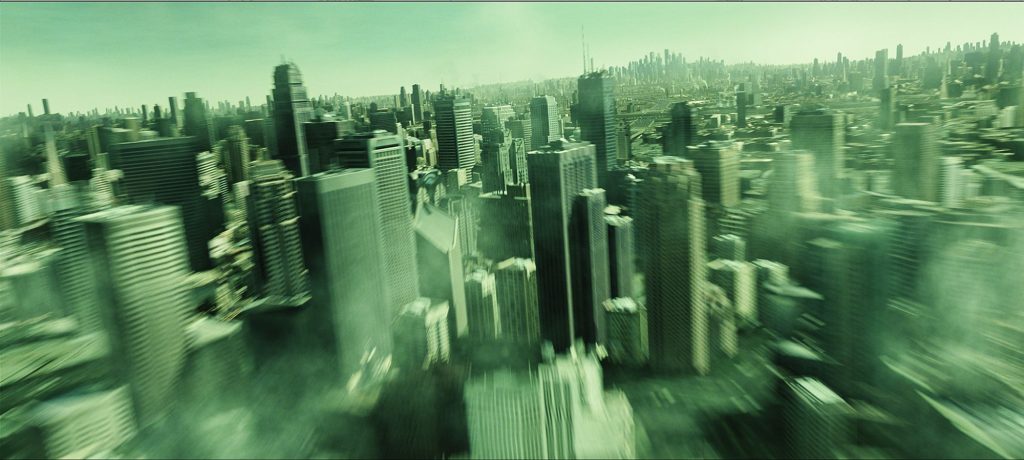
O.R.: Is it fair to say that the virtual reconstruction of real spaces is much alike the historical reinterpretation used in restoration? What is the major provocation for an architectin creating these virtual spaces?
V.B.: Digital set design for film has a rigid technical superstructure…
It is relatively easy to simulate a three-dimensional space for a perspective study, but the time consuming part is to bring that virtual space to the level of realism needed for a seamless integration in a film sequence. The parameters are strictly determined by the camera, the color space, existing light, correct texture calibration, correct digital to film transfer and vice-versa. I think that this technical part and working with a team containing many programmers, engineers, film technicians and colorists, with a different vocabulary and approach to design, was the most difficult. On the other hand, I was not the only architect, as a matter of fact, there are quite a few in this industry.
When I began working in this field I realized that, because of the financing system for film projects and of the obsession with technology that you find in most large production
studios, there is a chance to experiment with 3D software for spatial analysis and design that is hard to find in a typical architectural company. These programs surface sometimes later in mainstream architectural production. For instance, 3D scanners have been used for the first time in seismic engineering, being adopted and refined by the film industry, only to re-appear later on in historical preservation. Same with photogrammetric software as an integral part of 3D programs.

13 Ghosts
Warner Bros. 2002, Manex Entertainment
Activities: digital set-design, exterior design and 3D modeling, lights and color, digital extension of the existing set.
Authors:Vlad Bînă, Sean Hargreaves
Collaborator: Kenji Sweeney
The film set is a glass house with gliding panels, designed by Sean Hargreaves. The set was extended with a digital part. Vlad Bînă was responsible for the digital design of the exterior and the coordination of the panels’ movements, the conception and coordination of the digital set. Areas from inside the house were also digitally extended and integrated with the real objects through computer renderings.



